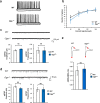Memory and synaptic plasticity are impaired by dysregulated hippocampal O-GlcNAcylation
- PMID: 28368052
- PMCID: PMC5377249
- DOI: 10.1038/srep44921
Memory and synaptic plasticity are impaired by dysregulated hippocampal O-GlcNAcylation
Abstract
O-GlcNAcylated proteins are abundant in the brain and are associated with neuronal functions and neurodegenerative diseases. Although several studies have reported the effects of aberrant regulation of O-GlcNAcylation on brain function, the roles of O-GlcNAcylation in synaptic function remain unclear. To understand the effect of aberrant O-GlcNAcylation on the brain, we used Oga+/- mice which have an increased level of O-GlcNAcylation, and found that Oga+/- mice exhibited impaired spatial learning and memory. Consistent with this result, Oga+/- mice showed a defect in hippocampal synaptic plasticity. Oga heterozygosity causes impairment of both long-term potentiation and long-term depression due to dysregulation of AMPA receptor phosphorylation. These results demonstrate a role for hyper-O-GlcNAcylation in learning and memory.
Conflict of interest statement
The authors declare no competing financial interests.
Figures





Similar articles
-
Acutely elevated O-GlcNAcylation suppresses hippocampal activity by modulating both intrinsic and synaptic excitability factors.Sci Rep. 2019 May 13;9(1):7287. doi: 10.1038/s41598-019-43017-9. Sci Rep. 2019. PMID: 31086206 Free PMC article.
-
O-GlcNAcylation of AMPA receptor GluA2 is associated with a novel form of long-term depression at hippocampal synapses.J Neurosci. 2014 Jan 1;34(1):10-21. doi: 10.1523/JNEUROSCI.4761-12.2014. J Neurosci. 2014. PMID: 24381264 Free PMC article.
-
The Dysregulation of OGT/OGA Cycle Mediates Tau and APP Neuropathology in Down Syndrome.Neurotherapeutics. 2021 Jan;18(1):340-363. doi: 10.1007/s13311-020-00978-4. Epub 2020 Nov 30. Neurotherapeutics. 2021. PMID: 33258073 Free PMC article.
-
Protein O-GlcNAcylation in cardiovascular diseases.Acta Pharmacol Sin. 2023 Jan;44(1):8-18. doi: 10.1038/s41401-022-00934-2. Epub 2022 Jul 11. Acta Pharmacol Sin. 2023. PMID: 35817809 Free PMC article. Review.
-
Roles of O-GlcNAcylation on amyloid-β precursor protein processing, tau phosphorylation, and hippocampal synapses dysfunction in Alzheimer's disease.Neurol Res. 2016 Feb;38(2):177-86. doi: 10.1080/01616412.2015.1133485. Epub 2016 Mar 14. Neurol Res. 2016. PMID: 27078700 Review.
Cited by
-
Acutely elevated O-GlcNAcylation suppresses hippocampal activity by modulating both intrinsic and synaptic excitability factors.Sci Rep. 2019 May 13;9(1):7287. doi: 10.1038/s41598-019-43017-9. Sci Rep. 2019. PMID: 31086206 Free PMC article.
-
O-GlcNAcase contributes to cognitive function in Drosophila.J Biol Chem. 2020 Jun 26;295(26):8636-8646. doi: 10.1074/jbc.RA119.010312. Epub 2020 Feb 24. J Biol Chem. 2020. PMID: 32094227 Free PMC article.
-
O-GlcNAc and EZH2-mediated epigenetic regulation of gene expression during consolidation of fear memories.Learn Mem. 2019 Aug 15;26(9):373-379. doi: 10.1101/lm.049023.118. Print 2019 Sep. Learn Mem. 2019. PMID: 31416910 Free PMC article.
-
O-GlcNAc cycling in the developing, adult and geriatric brain.J Bioenerg Biomembr. 2018 Jun;50(3):241-261. doi: 10.1007/s10863-018-9760-1. Epub 2018 May 22. J Bioenerg Biomembr. 2018. PMID: 29790000 Free PMC article. Review.
-
Modulation of synaptic transmission through O-GlcNAcylation.Mol Brain. 2024 Jan 2;17(1):1. doi: 10.1186/s13041-023-01072-4. Mol Brain. 2024. PMID: 38167470 Free PMC article. Review.
References
-
- Okuyama R. & Marshall S. UDP-N-acetylglucosaminyl transferase (OGT) in brain tissue: temperature sensitivity and subcellular distribution of cytosolic and nuclear enzyme. J Neurochem 86, 1271–1280 (2003). - PubMed
Publication types
MeSH terms
Substances
LinkOut - more resources
Full Text Sources
Other Literature Sources
Medical

